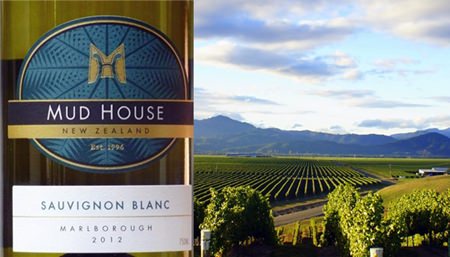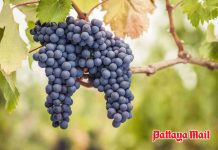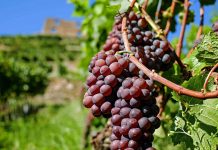Alcohol content is one of the few things about wine that’s reasonably easy to understand. It’s also easy to find on a label, or should be. The amount of alcohol in your wine, or indeed any other alcoholic drink is shown in terms of alcohol by volume, usually abbreviated to ABV. The system was introduced into Great Britain in 1980 and is now used throughout Europe, America and almost everywhere else. It’s convenient to use and the numbers are easy to remember. For example, most beers fall between 4% and 6% whereas wines are between 9% and 13%. Fortified wines like Sherry and Port are around 18% to 20% and liqueurs can go up to about 55%. At the top of the list of course come spirits which can contain anything between 40% and 80%.
Some writers have claimed recently that alcohol levels in wine are on the rise and that we are now seeing more wines at 14% and higher. The alcohol comes from the sugar in the grapes and as they ripen, they build up their sugar content which is converted to alcohol during fermentation. The more sugar in the grapes, the higher the potential alcohol of the wine and some grapes are naturally higher in sugar than others. It was not long ago when most table wines were sold at around 11% or 12% alcohol, but look around the supermarket these days and you are more likely to see 13% and 14% on the labels.
 The Woolshed Vineyard, Marlborough, NZ
The Woolshed Vineyard, Marlborough, NZ
There are several theories why this might be the case. Julian Alston, an agricultural economist at the University of California at Davis, has charted the sugar levels of grapes in California over the past thirty years. He’s found that they’re on their way up and has suggested a few possible reasons, including changes in climate and later harvests in the vineyard. In recent years, big-flavoured, fruity wines have become popular with wine drinkers and critics. One such critic is Robert Parker, considered the most influential wine writer in the world. He tends to reward richly-flavoured wines by giving them high scores, and because alcohol delivers flavour, some winemakers have responded by producing wines with higher alcohol content.
These two New Zealand wines are imported by Siam Winery but are not yet available at retail outlets in this country. However, in Pattaya you can taste them at the Amari Orchid Hotel’s excellent Mantra Restaurant. With the usual restaurant mark-up on wines, expect to pay around Bt. 1,500++ per bottle. The Marlborough Region of New Zealand, often known simply as Marlborough, is in the north east of the South Island. It’s really where the modern wine industry began in the 1970s and accounts for over sixty percent of the country’s vineyard area. The leading grape varieties in these parts are Sauvignon Blanc and Pinot Noir.
Mud House Marlborough Sauvignon Blanc 2011 (white), New Zealand
I have a feeling that most wine drinkers either adore Sauvignon Blanc passionately or they don’t. Traditionally, Sauvignon Blanc (SOH-vee-nyon BLAHN) comes from France, but this wine tastes refreshingly different to its distant Gallic cousins. It’s a delicate, pale straw colour with a tantalising and rather unexpected aroma. It smells fresh, fruity, cool and invigorating with reminders of gooseberries, grapefruit, dill and passion fruit. You’ll probably also pick up the Sauvignon trademark of wild grassy aromas, herbs and nettles. On the palate there’s an almost multi-dimensional flavour. It’s bold, extremely dry and sharply-focused, balanced by a bright zesty tang of grapefruit-like acidity. It’s medium-bodied with a satisfying, dry finish and at 13% alcohol content, it would match richly flavoured seafood and fish dishes. It would work well with many Thai and Asian dishes too.
I am not surprised that in 2011 it won a Gold Medal at the UK International Wine and Spirits Competition. Wine maker Nadine Worley has not only tamed the feisty Lady of the Loire by bringing out her sunnier qualities, but also preserved the essential crisp and fresh character of the grape. I reckon that’s quite an achievement and so it seems, do a lot of other people, for this wine has already acquired many international trophies and received critical acclaim from around the world. It’s been a consistent gold medal earner and won awards in Finland, San Francisco, Japan and Germany to name but a few.
Mud House Central Otago Pinot Noir 2011 (red), New Zealand
Central Otago is New Zealand’s most inland region, located in the southern half of the South Island and dominated by mountain ranges and clear blue rivers. Pinot Noir hails from Burgundy of course, where it makes some of the finest red wines in the world, invariably at breath-taking prices. This splendid wine is another award-winner and has given a new dimension to traditional Burgundy in terms of flavour, texture and depth. In some ways, it actually seems closer to a Shiraz.
It has an alluring fruity aroma that wafts out as soon as you pour the wine into the decanter. There are reminders of jammy red cherries, a touch of warm spice and plums, hints of oak and you might just detect a seductive hint of rose petals. The wine has a very soft texture with loads of rich fruit on the palate including cherry, red currant and a dash of herbs and roses in the background. There’s also a lively sharpness and a fine cut of acidity that balances out the fruit. This clean-tasting, supple wine has soft tannins and an oaky, persistent fruity finish. At 13.5% alcohol content this would make an excellent partner for roast beef, roast lamb or even roast duck.
About a third of the wine was aged in French oak barrels, to bring out the oaky quality while the rest of it was matured in stainless steel tanks, to preserve the bright fruit flavours. If you think you would enjoy a splendid Pinot Noir with a difference, why not pop into the Mantra one evening and give it a try?




